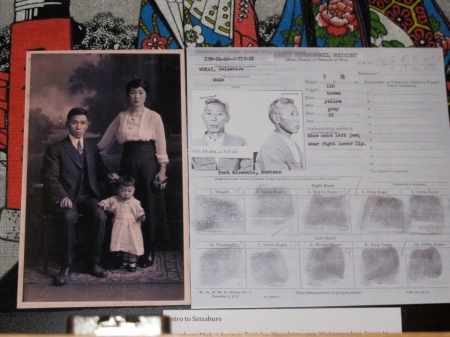 I’m following up on my last post about the Haiku Cubes and the Japanese American Experience exhibit with an interview with Tiko Mason. The concept and the content of the exhibit was her idea I thought I’d let her explain it to you.
I’m following up on my last post about the Haiku Cubes and the Japanese American Experience exhibit with an interview with Tiko Mason. The concept and the content of the exhibit was her idea I thought I’d let her explain it to you.
Pamela: Can you share with our readers where the idea for the library exhibit came from?
Tiko: This past summer I participated in the St. Mary’s Undergraduate Research Fellowship (SMURF) program. I had intended to research the Japanese-American experience from the arrival of the issei (first generation Japanese to come to America) to the yonsei (my generation) using my family’s personal experience as text. Prior to the project I knew my great-grandfather Seizaburo’s name, that he had lived in Seattle, and that something bad had happened to him during the war. I had no idea that on my first visit to the National Archives and Records Administration I would happen upon a gigantic file, replete with over a hundred documents, handwritten letters, memorandums from the Department of Justice and the FBI, all topped with Seizaburo’s mug shot and fingerprints. My project morphed into a creative engagement with this file, supported by other historical research, that grappled with my personal questions of identity in relation to this not-so-distant family member from the not-so-distant past. The documents in this exhibit come from that research.
Pamela: Had you read When the Emperor was Divine before you started your project?
Tiko: I did read When the Emperor was Divine prior to beginning the project (at the suggestion of my excellent adviser Professor Beth Charlebois). I also re-read it 3 or 4 times during the course of the summer (while doing my research). Julie Otsuka’s language and description of these events sparked my own creativity. I came to see so much of my great-grandfather Seizaburo in the father from the story, and there are points where the narrative eerily describes my own family’s experience.
Pamela: When you started doing research on your family did you imagine it ending up in an exhibit case?
Tiko: I never imagined that my family history would be so completely intertwined in American history and questions of race and identity. I certainly never imagined that pictures of my family members would be displayed in the St. Mary’s College library.
Pamela: What does it feel like to have your family history on display this way?
Tiko: Since I spent so much time this summer talking to people about my project (and ultimately presented it to the community), I am fairly comfortable having my personal life on public display. At the same time, it’s always hard to imagine that someone else could find your personal history interesting or compelling. I think that in general, the gains that come from sharing this type of painful, personal history outweigh the discomfort and vulnerability of putting it out there.
Pamela: What did your family think about your SMURF project and your turning it into an exhibit?
Tiko: My parents, aunts and uncles hugely support my efforts. No one in my family knew most of this information, and thanks to the project we now can fill in what had been a huge blank in our collective history. I do have older family members, of the nisei (second generation) who did not want to talk to me about the project, refused to be interviewed, and probably would not support its public display. Since they were there, and I wasn’t, I think this is a fair response too.
Pamela: What were you thinking when you choose the objects for the exhibit?
Tiko: In choosing documents for the exhibit, I picked the ones that I personally find most compelling. I wanted to create a sort of timeline that people could follow as they circle the case. I also wanted a stark juxtaposition between the picture of my great grandfather seated as a young man with his wife and his daughter (my grandmother) as a baby and his mug shot post-arrest as an old man. The actual objects in the exhibit (2 cups and an ochawan) are from Japan, passed down through my family for 100 years. They are a tangible connection to the past.
Pamela: Have you ever curated an exhibit before? Was it what you expected?
Tiko: I have never done anything like this before. It was significantly harder to organize, layout, and decide what to include than I anticipated.
Pamela: Does the exhibit look the way you imagined it would? I know you weren’t sure about the exhibit in the round when I first suggested it — how do you feel about how it turned out?
Tiko: I feel like it turned out well. I didn’t have a lot of vision for how it would turn out (being so inexperienced with curating), but I think given the space, the chronological organization makes sense and also creates visual interest. I hope lots of people stop by and take a look!
Pamela: What would like viewers to take away from the exhibit?
Tiko: I would like people to feel a little bit closer to this part of the American experience. I think it’s really easy to separate ourselves from the past, when in fact it informs so much of our present. I hope that people, particularly those who have read When the Emperor was Divine, gain a new personal and historical window into the Japanese internment experience.
Reblogged this on The SMCM Library Reading Circle and commented:
Add your thoughts here… (optional)